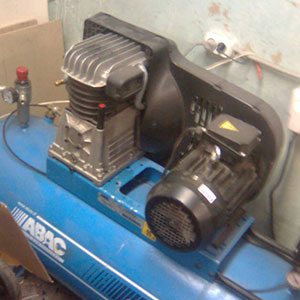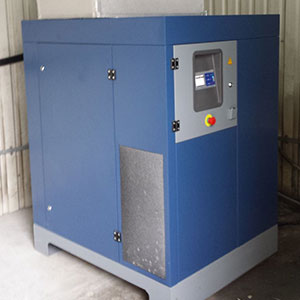Selecting the right air compressor is important for technical operations and businesses relying on compressed air.
There a variety of compressor types on the market. And each compressor type offers different advantages and disadvantages. Understanding these differences is key to optimizing your compressed air system's efficiency and reliability.
This article aims to provide a clear comparison of popular compressor types, focusing on their operational pros and cons. My goal is to assist technical professionals and end-users in making informed decisions based on their specific application requirements.
Air Compressor Types
Reciprocating piston compressor
This compressor type uses a piston, which moves inside a cylinder, to compress the air.
Reciprocating simply means ‘moving back-and-forth’. Usually it’s a piston that move back-and-forth, but it can also be a rubber membrane (membrane compressor).
 Reciprocating piston compressor
Reciprocating piston compressor
Two sets of valves take care of the air intake and exhaust. Piston compressors are available as lubricated and oil-free, and most of the time with 2 cylinders in V-shape. Very small piston compressors use only 1 cylinder.
The piston compressor is nowadays available from 1 HP to about 30 HP.
They are used a LOT for general-purpose applications (‘workshop-air’), where the air is used for hand-tools, cleaning dust, small paint jobs, etc. Together with the rotary screw compressor, it’s one of the most used compressor types.
Pros:
- Relatively cheap
- Easy maintenance (easy to understand the inner working)
- Suitable for high pressures
Cons:
- Very noisy! You really need to put this type of compressor in a sound-isolating box or in it’s own room.
- High outlet temperature of compressed air
- High oil content in air piping.
Learn more about reciprocating piston compressors
Rotary screw compressor (oil-injected or oil-free)
Another one of the popular compressor types is the rotary screw compressor.
There are two basic types of rotary screw compressors: oil-injected and oil-free.
 Rotary screw compressor
Rotary screw compressor
The oil-injected type is most common, because it has a much lower price-tag than the oil-free one (which you should only use if your application requires 100% oil-free air).
It uses two rotors (helical screws) to compress the air. The rotors have a very special shape and turn in opposite directions with very little clearance between them.
Air sucked in at one end gets trapped between the rotors, and get pushed to the other side of the rotors (the pressure-side).
Pros:
- Low noise level. You can just put in in your workshop without wearing ear-protection.
- These are the work-horses of the compressors and can supply a large amount of compressed air.
- Good energy-efficiency compared to piston-type compressors
- Relatively low end temperature of compressed air
- Possible to use energy recovery
Cons:
- Purchase price is much higher than piston-type compressors
- More complex design, good maintenance very important.
- Minimal air use (per day/week) is required to prevent water condensate forming (will create a lot
of problems with rust!)
Learn more about rotary screw compressors
Scroll Compressors
I like scroll compressors... they are 'elegant'.. They run smoothly, with almost no noise, no vibrations and use a clever design principle to compress the air. They are however one of the less seen compressor types.
 Inside of a scroll compressor. Photo: Atlas Copco
Inside of a scroll compressor. Photo: Atlas Copco
How do they work? They compress the air using two spiral elements.
One is stationary (it doesn't move), and the other one moves in small eccentric circles inside the other spiral.
Air gets trapped and because of the way the spirals move, gets transported in small air-pockets to the center of the spiral. It takes about 2.5 turn for the air to reach the compressed air output pipe in the center.
I haven't seen too many scroll compressors 'in the wild' (as compared to other compressor types).
Normally they are used in places where a small amount of oil-free and clean compressed air is needed (for example drinking water-treatment facilities, specialized factories or laboratories, etc). T
hey don't product a high air flow. If you need a lot of oil-free compressed air, go for an oil-free rotary screw compressor.
Pros:
- Very quiet. Really very quiet!
- Compact. A scroll compressor is very small.
- Simple design, not so many parts
- Low maintenance (hardly any)
- Oil-free design
Cons:
- Low capacity (flow, liters/minute or cfpm).
- Relatively expensive
- When the scroll-element fails, there's a very big chance you just have to buy a whole new element.
- The compressed air gets very hot! Much hotter than compared to other types of compressors
Learn more about scroll compressors
Choosing an air compressor
There are a lot of types of compressor to choose from. Choosing the right type of air compressor for your needs is very important, it will save you a lot of trouble and money in the long run.
After reading this page you should have a fairly good idea what kind of compressor is best for you.
What kind of compressor is right for you?
Which compressor type is right for you?
I can't tell you!
It all depends what you use it for! Do you have any specialized needs? Do you need a lot of air, or just a little bit? Always check your tools, machines and other air-users and calculate how much air (cfpm = cubic feet per minute), you need.
If you just need a small amount of air (power some tools, operate a small machine), the most obvious
choice would be to buy an oil-lubricated piston-type compressor.
Do you need oil-free air? Use special filters to filter out the oil, or buy an oil-free piston-type compressor (more expensive, maintenance and repairs will also be more expensive compared to oil lubricated compressors).
Do you need more air? For example, do you use compressed air to sand-blast or operate one or more machines that use a lot of air, then the obvious choice would be a rotary-screw compressor. They range from small (5 kW) to very big (1000 kW or more).
Pressure VS Flow / Capacity
The difference between these compressors is both the PRESSURE and the FLOW (cubic meters per minute, or cubic feet per minute). Most common pressure is 7 to 8 bars.
Reciprocating piston compressors are most often seen for high-pressure / low flow applications (up to 30 bars), while rotary screw compressors are used for continuous applications (high flow, 7 or 8 bar)..
Buying Guide: buying the right type of air compressor
Looking to buy and air compressor, but don't know which type of air compressor is the best for your application?
Check out my air compressor buying guide.
